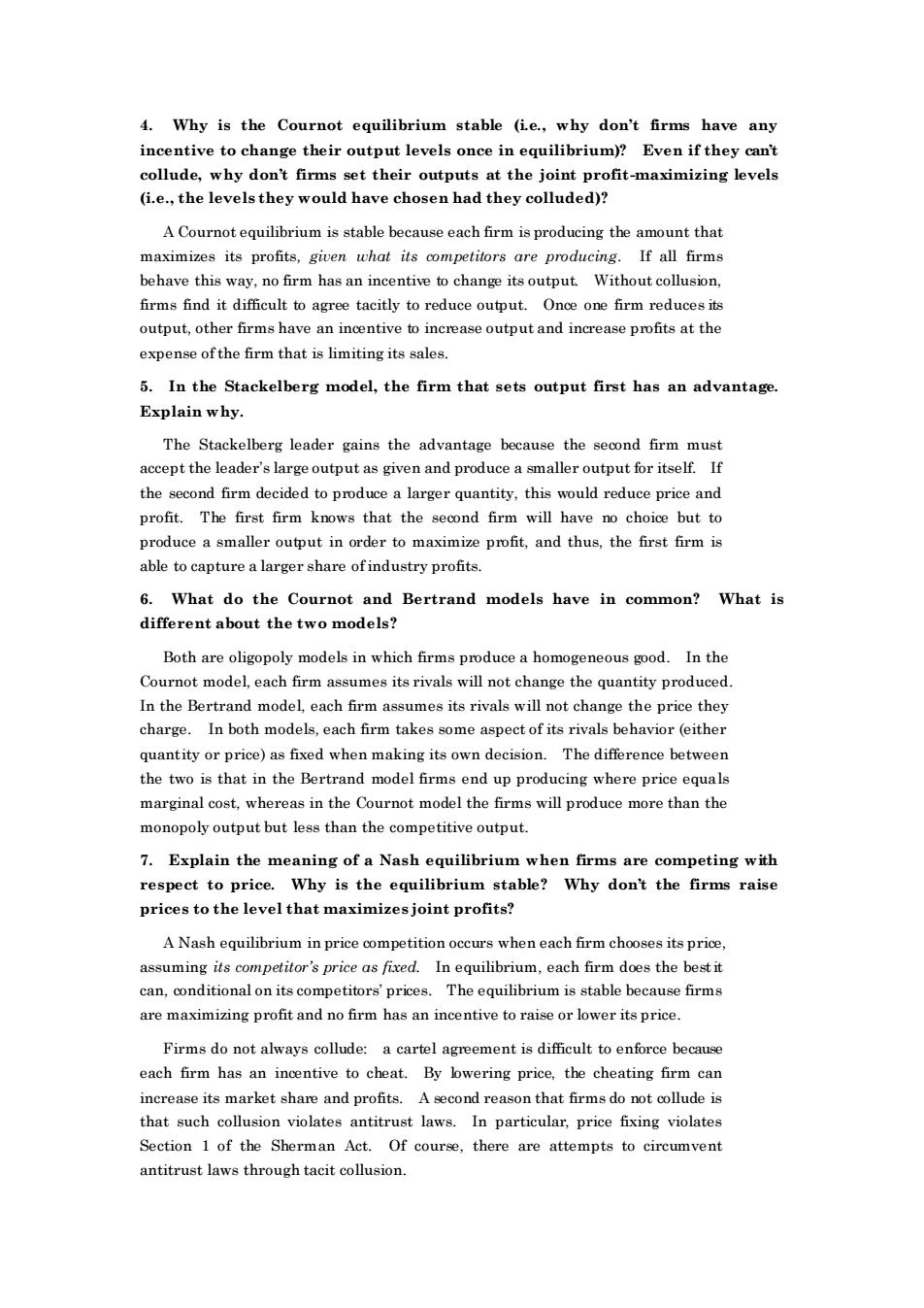正在加载图片...

4.Why is the Cournot equilibrium stable (ie.,why don't firms have any incentive to change their output levels once in equilibrium)?Even if they can't collude why don't firms set their outputs at the joint profit-maximizing levels (i.e.,the levels they would have chosen had they colluded)? A Cournot equilibrium is stable because each firm is producing the amount that maximizes its profits,given what its competitors are producing.If all firms behave this way,no firm has an incentive to change its output Without collusion. firms find it difficult to agree tacitly to reduce ouput.Once one firm reduces its output,other firms hay in entive t expense of the firm that is limiting its sales 5.In the Stackelberg model,the firm that sets output first has an advantage Explain why. The Stackelberg leader gains the advantage because the second firm must accept the leader's large output as given and produce a smaller output for itself.If larger quantity,this would reduce price and profit.The first firm knowe that the snd frm will have no produce a smaller output in order to maximize profit,and thus,the first firm is able to capture a larger share ofindustry profits. 6.What do the Cournot and Bertrand models have in common?What is different about the two models? Both are oligopoly models in which firms produce a homogeneous good.In the Cournot model,each firm assumes its rivals will not change the quantit yproduced and model, each not change the price the charge In both models.each firm takes some aspect of its rivals behavior(either quantity or price)as fixed when making its own decision.The difference between the two is that in the Bertrand model firms end up producing where price equals marginal cost,whereas in the Cournot model the firms will produce more than the monopoly output but less than the competitive outpu 7.Explain the meaning of a Nash equilibrium when firm competing with respect to price. Why is the equilibrium stable? Why don't the firms rais prices to the level that maximizes joint profits? A Nash equilibrium in price competition occurs when each firm chooses its price assuming its competitor's price as fixed.In equilibrium.each firm does the best it can.conditional on its competitors'prices.The equilibrium is stable because firms are maximizing profit and no firm has an incentive to raise or lower its price each firm has an incentive to cheat.By bwering price,the cheating firm can increase its market share and profits.A second reason that firms do not collude is that such collusion violates antitrust laws.In particular,price fixing violates Section 1 of the Sherman Act.Of course.there are attempts to circumvent antitrust laws through tacit colusion 4. Why is the Cournot equilibrium stable (i.e., why don’t firms have any incentive to change their output levels once in equilibrium)? Even if they can’t collude, why don’t firms set their outputs at the joint profit -maximizing levels (i.e., the levels they would have chosen had they colluded)? A Cournot equilibrium is stable because each firm is producing the amount that maximizes its profits, given what its competitors are producing. If all firms behave this way, no firm has an incentive to change its output. Without collusion, firms find it difficult to agree tacitly to reduce output. Once one firm reduces its output, other firms have an incentive to increase output and increase profits at the expense of the firm that is limiting its sales. 5. In the Stackelberg model, the firm that sets output first has an advantage. Explain why. The Stackelberg leader gains the advantage because the second firm must accept the leader’s large output as given and produce a smaller output for itself. If the second firm decided to produce a larger quantity, this would reduce price and profit. The first firm knows that the second firm will have no choice but to produce a smaller output in order to maximize profit, and thus, the first firm is able to capture a larger share of industry profits. 6. What do the Cournot and Bertrand models have in common? What is different about the two models? Both are oligopoly models in which firms produce a homogeneous good. In the Cournot model, each firm assumes its rivals will not change the quantity produced. In the Bertrand model, each firm assumes its rivals will not change the price they charge. In both models, each firm takes some aspect of its rivals behavior (either quantity or price) as fixed when making its own decision. The difference between the two is that in the Bertrand model firms end up producing where price equals marginal cost, whereas in the Cournot model the firms will produce more than the monopoly output but less than the competitive output. 7. Explain the meaning of a Nash equilibrium when firms are competing with respect to price. Why is the equilibrium stable? Why don’t the firms raise prices to the level that maximizes joint profits? A Nash equilibrium in price competition occurs when each firm chooses its price, assuming its competitor’s price as fixed. In equilibrium, each firm does the best it can, conditional on its competitors’ prices. The equilibrium is stable because firms are maximizing profit and no firm has an incentive to raise or lower its price. Firms do not always collude: a cartel agreement is difficult to enforce because each firm has an incentive to cheat. By lowering price, the cheating firm can increase its market share and profits. A second reason that firms do not collude is that such collusion violates antitrust laws. In particular, price fixing violates Section 1 of the Sherman Act. Of course, there are attempts to circumvent antitrust laws through tacit collusion